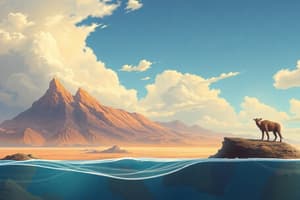Podcast
Questions and Answers
What is the primary purpose of index fossils?
What is the primary purpose of index fossils?
- To identify the nutritional habits of ancient organisms
- To classify living species of today
- To determine the age of geological formations (correct)
- To describe the physical characteristics of rocks
Which characteristic is NOT true for index fossils?
Which characteristic is NOT true for index fossils?
- They are limited in time span
- They are abundant and easily identifiable
- They have a long geologic range (correct)
- They have a wide geographic distribution
Which fossil is an example of a Jurassic index fossil?
Which fossil is an example of a Jurassic index fossil?
- _Billingsella corrugata_
- _Venericardia planicosta_
- _Perisphinctes tiziani_ (correct)
- _Cactocrinus multibrachiatus_
What describes the term 'geologic range'?
What describes the term 'geologic range'?
Which of these is NOT an index fossil group mentioned?
Which of these is NOT an index fossil group mentioned?
What common characteristic do ammonites and gastropods share?
What common characteristic do ammonites and gastropods share?
Which index fossil is classified from the Carboniferous period?
Which index fossil is classified from the Carboniferous period?
What makes a fossil an 'index fossil'?
What makes a fossil an 'index fossil'?
Flashcards
Index Fossil
Index Fossil
A fossil widely distributed, common, and limited in time, used to determine ages of rock layers and relate them.
Geologic range
Geologic range
The total time span an organism existed on Earth.
Fossil
Fossil
A preserved trace of a plant or animal from the past, found in rock layers.
Index fossil uses
Index fossil uses
Signup and view all the flashcards
Index fossil criteria
Index fossil criteria
Signup and view all the flashcards
Ammonite
Ammonite
Signup and view all the flashcards
Brachiopod
Brachiopod
Signup and view all the flashcards
Trace fossil
Trace fossil
Signup and view all the flashcards
Study Notes
Index Fossils
- Index fossils are widely distributed fossils with a limited time span.
- They are used to determine the age of rocks and establish relationships between rock layers.
- "Fossil" literally means anything dug from the earth.
- Fossils are remnants of plants or animals, or related items, providing evidence of past life.
- Fossil taxa are unique sets of fossils that characterize rock layers.
- William Smith, a British engineer, recognised the use of fossils to correlate rock layers across vast distances.
- Index fossils, or guide fossils, are restricted to specific geologic horizons.
- Some index fossils represent animal groups.
Animal Index Fossils
- Ammonites: Molluscs with coiled shells; Perisphinctes tiziani (Jurassic) and Trophites subbullatus (Triassic) are examples.
- Gastropods: Molluscs with asymmetrical, spirally-twisted shells; Nerinea trinodosa (Jurassic) is an example.
- Pelecypods: Bivalve shelled molluscs with a tongue-shaped foot; Venericardia planicosta (Tertiary) is an example.
- Brachiopods: Bilaterally symmetrical animals with bivalve shells; Billingsella corrugata (Cambrian) and Dictyoclostus americanus (Carboniferous) are examples.
- Crinoids: Marine invertebrates with cup-shaped bodies and feathery tentacles; Cactocrinus multibrachiatus (Carboniferous) is an example.
- Trilobites: Extinct marine arthropods with three lobes; Paradoxides pinus and Bathyurus extans are examples from the Cambrian and Ordovician periods, respectively.
Characteristics of Index Fossils
- An organism must have lived for only a short period of Earth's history.
- Numerous fossils of the organism must be found in various rock layers.
- The fossils must be found over a wide geographical area.
- The organism's characteristics must be unique.
Studying That Suits You
Use AI to generate personalized quizzes and flashcards to suit your learning preferences.




